首页 > 代码库 > nginx反向代理tomcat集群达到负载均衡,同时使用proxy_cache做web缓存
nginx反向代理tomcat集群达到负载均衡,同时使用proxy_cache做web缓存
Nginx最早是作为一款优秀的反向代理软件,以高并发下的卓越性能被越来越多的用户所用户,国内最早研究nginx的是张宴,该大牛的博客地址:http://zyan.cc/ 。但是随着需求的发展,nginx的功能已经不再单单是反向代理,现在已经更倾向作为web容器。
Nginx从0.7.48版本开始,支持了类似Squid的缓存功能。Nginx的Web缓存服务主要由proxy_cache相关指令集和fastcgi_cache相关指令集构成,前者用于反向代理时,对后端内容源服务器进行缓存,后者主要用于对FastCGI的动态程序进行缓存。两者的功能基本上一样。自Nginx 0.8.32版本,proxy_cache和fastcgi_cache已经比较完善,加上第三方的ngx_cache_purge模块(用于清除指定URL的缓存),性能不亚于squid,更为关键的是,您在拥有一个反向代理服务器的同时,还可以同时拥有一个高性能的web缓存服务器,鱼与熊掌兼得的快感自然不言而喻!
先看环境:
hadoop1.updb.com 192.168.0.101 nginx server
hadoop2.updb.com 192.168.0.102 tomcat server
hadoop3.updb.com 192.168.0.103 tomcat server
hadoop4.updb.com 192.168.0.104 tomcat server
hadoop5.updb.com 192.168.0.105 tomcat server
操作系统:
centos
Nginx版本:
nginx-1.7.6.tar.gz,采用源码编译安装
Ngx_cache_purge版本:
ngx_cache_purge-2.1.tar.gz
Tomcat版本:
apache-tomcat-7.0.56.tar.gz
JDK版本:
jdk-7u60-linux-x64.rpm
最终架构:
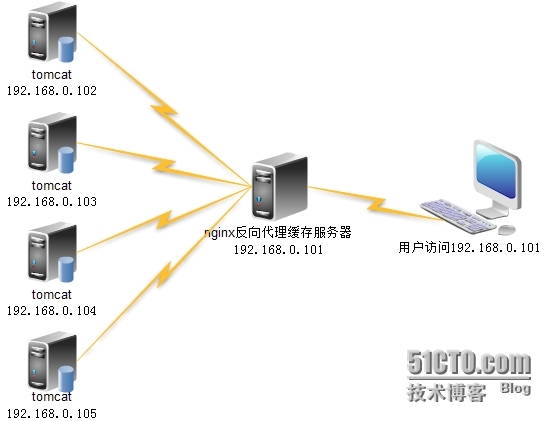
在弄明白架构之后,我们开始着手一步步来实现:
1、安装jdk + tomcat
hadoop2、hadoop3、hadoop4、hadoop5上安装jdk
rpm -ivh jdk-7u60-linux-x64.rpm
配置环境变量
[root@hadoop2 ~]# cat .bash_profile # .bash_profile # Get the aliases and functions if [ -f ~/.bashrc ]; then . ~/.bashrc fi # User specific environment and startup programs PATH=$PATH:$HOME/bin export JAVA_HOME=/usr/java/jdk1.7.0_60 export JRE_HOME=/usr/java/jdk1.7.0_60/jre export CLASSPATH=./:/usr/java/jdk1.7.0_60/lib:/usr/java/jdk1.7.0_60/jre/lib export PATH
使环境变量生效,并验证java环境是否安装成功
[root@hadoop2 ~]# . .bash_profile [root@hadoop2 ~]# java -version java version "1.7.0_60" Java(TM) SE Runtime Environment (build 1.7.0_60-b19) Java HotSpot(TM) 64-Bit Server VM (build 24.60-b09, mixed mode)
hadoop2、hadoop3、hadoop4、hadoop5上安装tomcat,在webapps下创建测试目录shop和测试文件hadoop.html和test.jsp,测试文件中的内容为每个tomcat节点的主机名和IP地址,方便后边测试负载均衡
[root@hadoop2 ~]# tar xf apache-tomcat-7.0.56.tar.gz -C /opt/ [root@hadoop2 ~]# cd /opt/apache-tomcat-7.0.56/webapps/ [root@hadoop2 webapps]# mkdir shop [root@hadoop2 webapps]# vi shop/hadoop.html hadoop2.updb.com 192.168.0.102 [root@hadoop2 webapps]# vi shop/test.jsp this is hadoop2 root`s jsp!
将tomcat的bin目录配置到环境变量,并使更改生效,并启动tomcat
## 设置环境变量 [root@hadoop2 ~]# cat .bash_profile # .bash_profile # Get the aliases and functions if [ -f ~/.bashrc ]; then . ~/.bashrc fi # User specific environment and startup programs PATH=$PATH:$HOME/bin:/opt/apache-tomcat-7.0.56/bin export JAVA_HOME=/usr/java/jdk1.7.0_60 export JRE_HOME=/usr/java/jdk1.7.0_60/jre export CLASSPATH=./:/usr/java/jdk1.7.0_60/lib:/usr/java/jdk1.7.0_60/jre/lib export PATH ## 使设置生效 [root@hadoop2 ~]# . .bash_profile ## 启动tomcat [root@hadoop2 ~]# startup.sh Using CATALINA_BASE: /opt/apache-tomcat-7.0.56 Using CATALINA_HOME: /opt/apache-tomcat-7.0.56 Using CATALINA_TMPDIR: /opt/apache-tomcat-7.0.56/temp Using JRE_HOME: /usr/java/jdk1.7.0_60/jre Using CLASSPATH: /opt/apache-tomcat-7.0.56/bin/bootstrap.jar:/opt/apache-tomcat-7.0.56/bin/tomcat-juli.jar Tomcat started.
测试tomcat是否正常工作,浏览器中访问,能够正常显示测试页面,表明工作正常。
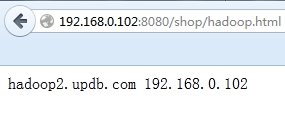
3、4、5节点安装上述方法安装,注意测试文件中的内容改为自己的主机名和IP地址。
2、安装nginx + ngx_cache_purge
首先下载nginx-1.7.6.tar.gz、ngx_cache_purge-2.1.tar.gz到hadoop1服务器上,首先安装ngx-cache_purge,只需要解压tar包就可以了
[root@hadoop1 pub]# tar xf ngx_cache_purge-2.1.tar.gz -C /opt/
安装nginx,过程中需要将ngx_cahce_purge模块编译进来
[root@hadoop1 pub]# tar xf nginx-1.7.6.tar.gz -C /opt/ [root@hadoop1 pub]# cd /opt/nginx-1.7.6/ [root@hadoop1 pub]# ./configure --user=www --group=www --add-module=/opt/ngx_cache_purge-2.1 --prefix=/usr/local/nginx --with-http_stub_status_module --with-http_ssl_module [root@hadoop1 pub]# make && make install
关于源码安装nginx,比较简单,如果过程中遇到问题可以到网上看看,都能找到答案,也可以在下面留言,一起讨论。
为了方便管理,为nginx编写服务脚本
[root@hadoop1 ~]# vi /etc/init.d/nginx
#!/bin/bash
#
#chkconfig: - 85 15
#description: this script use to manage nginx process.
#
#set -x
. /etc/rc.d/init.d/functions
procnum=`ps -ef |grep "/usr/local/nginx/sbin/nginx"|grep -v "grep"|wc -l`
start () {
if [ "$procnum" -eq 1 -a -f /usr/local/nginx/logs/nginx.pid ]; then
echo -n "Starting nginx:"
success
echo
else
/usr/local/nginx/sbin/nginx
if [ "$?" -eq 0 ]; then
echo -n "Starting nginx:"
success
echo
else
echo -n "Starting nginx:"
failure
echo
exit 4
fi
fi
}
stop () {
if [ "$procnum" -eq 1 -a -f /usr/local/nginx/logs/nginx.pid ]; then
/usr/local/nginx/sbin/nginx -s stop
if [ "$?" -eq 0 ]; then
echo -n "Stopping nginx:"
success
echo
else
echo -n "Stopping nginx:"
failure
echo
exit 3
fi
else
echo -n "Stopping nginx:"
success
echo
fi
}
case $1 in
start)
start
;;
stop)
stop
;;
restart)
stop
sleep 1
start
;;
reload)
if [ "$procnum" -eq 1 -a -f /usr/local/nginx/logs/nginx.pid ]; then
/usr/local/nginx/sbin/nginx -s reload
else
echo "nginx is not running!please start nginx first..."
exit 2
fi
;;
status)
if [ "$procnum" -eq 1 -a -f /usr/local/nginx/logs/nginx.pid ]; then
echo "nginx is running..."
else
echo "nginx is not running..."
fi
;;
*)
echo "Usage : nginx [ start|stop|reload|restart|status ]"
exit 1
;;
esac然后授予脚本可执行权限,并加入chkconfig开机自启动,并测试
[root@hadoop1 ~]# chmod +x /etc/init.d/nginx [root@hadoop1 ~]# chkconfig nginx on [root@hadoop1 ~]# /etc/init.d/nginx start Starting nginx: [ OK ] [root@hadoop1 ~]# /etc/init.d/nginx status nginx is running... [root@hadoop1 ~]# /etc/init.d/nginx stop Stopping nginx: [ OK ]
3、配置nginx,实现反向代理和web缓存
[root@hadoop1 ~]# vi /usr/local/nginx/conf/nginx.conf
user www www;
worker_processes 8;
error_log /usr/local/nginx/logs/error.log crit;
pid /usr/local/nginx/logs/nginx.pid;
##
events {
use epoll;
worker_connections 65535;
}
http {
include mime.types;
default_type application/octet-stream;
access_log /usr/local/nginx/logs/access.log;
charset utf-8;
sendfile on;
tcp_nopush on;
keepalive_timeout 60;
client_body_buffer_size 512k;
proxy_connect_timeout 5;
proxy_read_timeout 60;
proxy_send_timeout 5;
proxy_buffer_size 16k;
proxy_buffers 4 64k;
proxy_busy_buffers_size 128k;
proxy_temp_file_write_size 128k;
gzip on;
gzip_min_length 1k;
gzip_buffers 4 16k;
gzip_http_version 1.1;
gzip_comp_level 2;
gzip_types text/plain application/x-javascript text/css application/xml;
gzip_vary on;
## 设置缓存临时目录
proxy_temp_path /data/proxy_temp_dir;
## 设置缓存目录,并设置Web缓存区名称为cache_one,内存缓存空间大小为200MB,1天没有被访问的内容自动清除,硬盘缓存空间大小为30GB。
proxy_cache_path /data/proxy_cache_dir levels=1:2 keys_zone=cache_one:200m inactive=1d max_size=30g;
## 设置代理的后端tomcat集群
upstream web_server {
server 192.168.0.102:8080 weight=1 max_fails=2 fail_timeout=30s;
server 192.168.0.103:8080 weight=1 max_fails=2 fail_timeout=30s;
server 192.168.0.104:8080 weight=1 max_fails=2 fail_timeout=30s;
server 192.168.0.105:8080 weight=1 max_fails=2 fail_timeout=30s;
}
server {
listen 80; ## nginx监听端口
server_name 192.168.0.101; ## 设置nginx的主机名或IP地址
root html; ## nginx站点的根目录
index index.html index.htm index.jsp;
location / {
proxy_pass http://web_server; ## 这里设置要代理的集群名称
proxy_set_header Host $host;
proxy_set_header X-Forwarded-For $proxy_add_x_forwarded_for;
proxy_set_header X-Real-IP $remote_addr;
# 如果后端的服务器返回502、504、执行超时等错误,自动将请求转发到upstream负载均衡池中的另一台服务器,实现故障转移
proxy_next_upstream http_502 http_504 error timeout invalid_header;
proxy_cache cache_one;
# 对不同的HTTP状态码设置不同的缓存时间
proxy_cache_valid 200 304 12h;
# 以域名、URI、参数组合成Web缓存的Key值,Nginx根据Key值哈希,存储缓存内容到二级缓存目录内
proxy_cache_key $host$uri$is_args$args;
}
## 用于清除缓存,访问http://192.168.0.101/purge/shop/hadoop.html来清除http://192.168.0.101/shop/hadoop.html的页面缓存
location ~ /purge(/.*) {
allow 127.0.0.1;
allow 192.168.0.0/16;
deny all;
proxy_cache_purge cache_one $host$1$is_args$args;
}
## 扩展名以.php、.jsp、.cgi、.jhtml结尾的动态应用程序不缓存。
location ~ .*\.(php|jsp|cgi|jhtml)?$ {
proxy_pass http://web_server;
proxy_set_header Host $host;
proxy_set_header X-Forwarded-For $proxy_add_x_forwarded_for;
proxy_set_header X-Real-IP $remote_addr;
proxy_cache cache_one;
proxy_cache_valid 200 304 12h;
proxy_cache_key $host$uri$is_args$args;
}
## 关闭访问日志
access_log off;
}
}然后重启nginx
[root@hadoop1 ~]# /etc/init.d/nginx restart Stopping nginx: [ OK ] Starting nginx: [ OK ]
4、效果测试
测试静态页面的负载均衡和缓存,第一次访问http://192.168.0.101/shop/hadoop.html
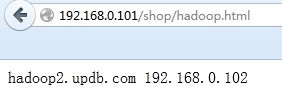
然后清除缓存,并再次访问http://192.168.0.101/shop/hadoop.html

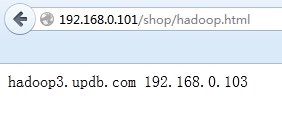
可以看出,当第一次访问时,通过nginx的反向代理,请求被转发到了hadoop2上的tomcat上。而且对于这次请求,nginx已经成功缓存到了静态页面,当清楚缓存后,再次访问相同的地址,请求则被转发到了hadoop3上的tomcat上,说明已经实现了负载均衡。
测试图片能否被缓存,第一次访问http://192.168.0.101/shop/QQ.jpg


可见,上面nginx的配置,已经成功的缓存到了图片和静态页面,下面我们测试动态页面能否被缓存
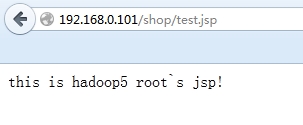
访问192.168.0.101/shop/test.jsp,发现每刷新一次,页面内容都会发生改变,说明请求在后端tomcat集群上轮询,并不是去的缓存,说明动态程序并没有没被缓存,也可以使用purge来验证,如下:

说明动态程序并没有被缓存到nginx中来,验证了上面nginx的配置文件是正确的,至此,已经实现了nginx反向代理后端tomcat集群实现负载均衡,同时使用proxy_cache来缓存网站的静态文件,一箭双雕!
5、总结
从上面的配置中可以看到使用nginx来做为反向代理和web缓存是如此的轻松,而且功能是如此的强大。比较关键的是,在满足需求的情况下,不用单独的使用缓存层(比如用squid实现),降低了运维的成本,而且在系统出现故障的时候,可以快速的定位故障点,当应用不可用时,只需要分别访问后端的tomcat和nginx就可以判断问题出现在哪一层上。而且在性能上,Nginx对多核CPU的利用,胜过Squid不少。另外,在反向代理、负载均衡、健康检查、后端服务器故障转移、Rewrite重写、易用 性上,Nginx也比Squid强大得多,可以考虑使用nginx来替换你的squid。
本文出自 “勇敢向前,坚决向左” 博客,请务必保留此出处http://quenlang.blog.51cto.com/4813803/1570352
nginx反向代理tomcat集群达到负载均衡,同时使用proxy_cache做web缓存
